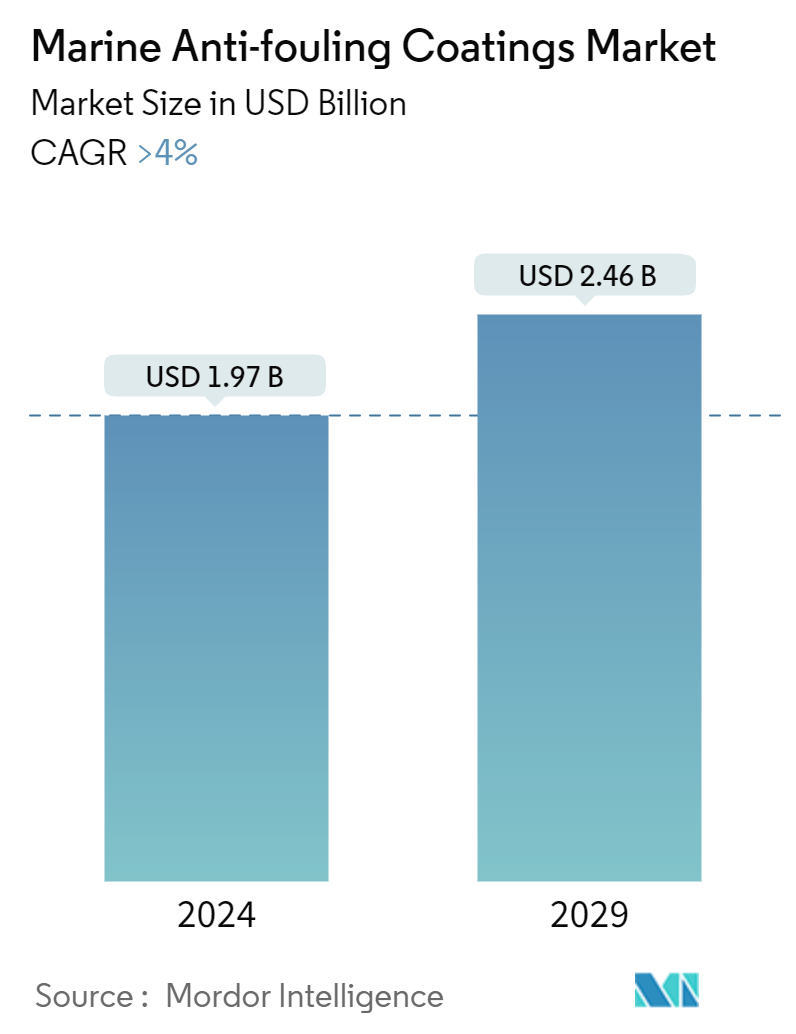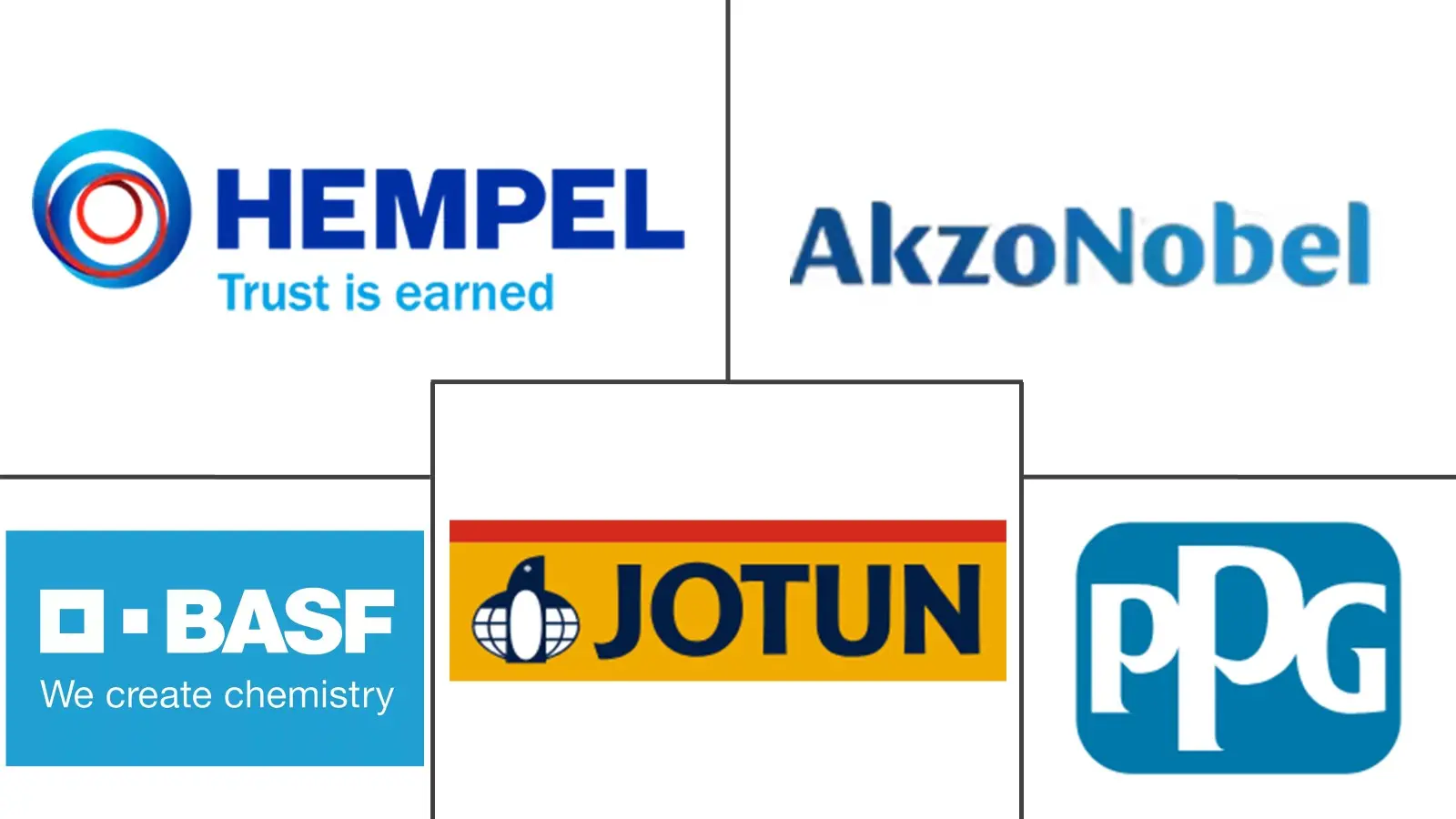Market Size of Marine Anti-fouling Coatings Industry

| Study Period | 2019 - 2029 |
| Market Size (2024) | USD 1.97 Billion |
| Market Size (2029) | USD 2.46 Billion |
| CAGR (2024 - 2029) | 4.00 % |
| Fastest Growing Market | Asia-Pacific |
| Largest Market | Asia-Pacific |
Major Players
*Disclaimer: Major Players sorted in no particular order |
Marine Anti-fouling Coatings Market Analysis
The Marine Anti-fouling Coatings Market size is estimated at USD 1.97 billion in 2024, and is expected to reach USD 2.46 billion by 2029, growing at a CAGR of greater than 4% during the forecast period (2024-2029).
The COVID-19 outbreak in 2020 caused a global lockdown, a break in supply chains and manufacturing, and a stop in production, all of which negatively impacted the market. However, things started to get better in mid-2021, which allowed the market to resume its upward trend for the remainder of the projected period.
- The market is growing because more leisure boats and cruise ships are being made, there are more ship repairs and maintenance jobs, and the oil and gas industry is buying more.
- On the other hand, the growth of the market studied is being slowed down by strict government rules and more people buying high-quality, long-lasting products.
- However, people are spending more money on luxury goods, and new coatings and application technology are likely to open up opportunities for the market studied during the forecast period.
- Due to the rising demand from the shipbuilding industry, Asia-Pacific dominated the market.
Marine Anti-fouling Coatings Industry Segmentation
Antifouling coatings are a type of coating that is put on the outer (outboard) layer of a ship or boat's hull to stop the growth of subaquatic organisms that stick to the hull and can hurt the performance and durability of the vessel and make it harder to move. It also acts as a barrier against corrosion on metal hulls that may degrade and weaken the metal or improve the flow of water past the hull of a fishing vessel.
The marine antifouling coatings market is segmented by type, application, and geography. By type, the market is segmented into copper-based, self-polishing, hybrid, and other types (organometallic, silane). By application, the market is segmented into hull coatings, tank coatings, and other applications (yachts and vessels). The report also covers the market size and forecasts for marine antifouling coatings in 27 countries across major regions. For each segment, market sizing and forecasts were made on the basis of value (USD).
| By Type | |
| Copper-based | |
| Self-polishing (Silver-based) | |
| Hybrid | |
| Other Types (Organo Metallic, Silane) |
| By Application | |
| Hull Coatings | |
| Tank Coatings | |
| Other Applications (Yachts and Vessels) |
| By Geography | |||||||||||
| |||||||||||
| |||||||||||
| |||||||||||
| |||||||||||
|
Marine Anti-fouling Coatings Market Size Summary
The marine antifouling coatings market is poised for significant growth over the forecast period, driven by increasing demand from the shipbuilding industry and the rising production of leisure boats and cruise ships. The market experienced disruptions due to the COVID-19 pandemic, which affected supply chains and manufacturing processes. However, recovery began in mid-2021, allowing the market to regain its upward trajectory. The Asia-Pacific region, particularly countries like China, Japan, and South Korea, dominates the market due to its robust shipbuilding and repair activities. The demand for antifouling coatings is primarily fueled by the need to protect underwater hulls of vessels from marine organisms, thereby enhancing their longevity and performance.
The market is characterized by a consolidated structure, with a few key players such as PPG Industries Inc., Akzo Nobel NV, Hempel A/S, Jotun, and BASF SE holding significant market shares. These companies are actively innovating to meet the evolving demands of the industry, as evidenced by recent product launches and technological advancements. For instance, PPG Industries Inc. introduced a copper-free antifouling coating focused on sustainability and performance, while Hempel A/S expanded its production facilities to cater to growing demand. Despite challenges posed by stringent regulations and a shift towards high-quality, durable products, the market is expected to benefit from increased spending on luxury goods and advancements in coating technologies, which are likely to create new opportunities for growth.
Marine Anti-fouling Coatings Market Size - Table of Contents
-
1. MARKET DYNAMICS
-
1.1 Drivers
-
1.1.1 Increasing Production of Leisure Boats and Cruise Ships
-
1.1.2 Increase in Ship Repairs and Maintenance Activities
-
1.1.3 Surging Demand from Oil and Gas Industry
-
-
1.2 Restraints
-
1.2.1 Stringent Government Regulations
-
1.2.2 Increased Usage of High-standard Durable Products
-
-
1.3 Industry Value Chain Analysis
-
1.4 Porter's Five Forces Analysis
-
1.4.1 Bargaining Power of Suppliers
-
1.4.2 Bargaining Power of Buyers
-
1.4.3 Threat of New Entrants
-
1.4.4 Threat of Substitute Products and Services
-
1.4.5 Degree of Competition
-
-
-
2. MARKET SEGMENTATION (Market Size in Value)
-
2.1 By Type
-
2.1.1 Copper-based
-
2.1.2 Self-polishing (Silver-based)
-
2.1.3 Hybrid
-
2.1.4 Other Types (Organo Metallic, Silane)
-
-
2.2 By Application
-
2.2.1 Hull Coatings
-
2.2.2 Tank Coatings
-
2.2.3 Other Applications (Yachts and Vessels)
-
-
2.3 By Geography
-
2.3.1 Asia-Pacific
-
2.3.1.1 China
-
2.3.1.2 India
-
2.3.1.3 Japan
-
2.3.1.4 South Korea
-
2.3.1.5 Thailand
-
2.3.1.6 Vietnam
-
2.3.1.7 Indonesia
-
2.3.1.8 Malaysia
-
2.3.1.9 Rest of Asia-Pacific
-
-
2.3.2 North America
-
2.3.2.1 United States
-
2.3.2.2 Canada
-
2.3.2.3 Mexico
-
-
2.3.3 Europe
-
2.3.3.1 Germany
-
2.3.3.2 United Kingdom
-
2.3.3.3 France
-
2.3.3.4 Italy
-
2.3.3.5 Spain
-
2.3.3.6 Russia
-
2.3.3.7 NORDIC Countries
-
2.3.3.8 Turkey
-
2.3.3.9 Rest of Europe
-
-
2.3.4 South America
-
2.3.4.1 Brazil
-
2.3.4.2 Argentina
-
2.3.4.3 Colombia
-
2.3.4.4 Rest of South America
-
-
2.3.5 Middle East and Africa
-
2.3.5.1 Saudi Arabia
-
2.3.5.2 South Africa
-
2.3.5.3 Nigeria
-
2.3.5.4 United Arab Emirates
-
2.3.5.5 Qatar
-
2.3.5.6 Egypt
-
2.3.5.7 Rest of Middle East and Africa
-
-
-
Marine Anti-fouling Coatings Market Size FAQs
How big is the Marine Anti-fouling Coatings Market?
The Marine Anti-fouling Coatings Market size is expected to reach USD 1.97 billion in 2024 and grow at a CAGR of greater than 4% to reach USD 2.46 billion by 2029.
What is the current Marine Anti-fouling Coatings Market size?
In 2024, the Marine Anti-fouling Coatings Market size is expected to reach USD 1.97 billion.

